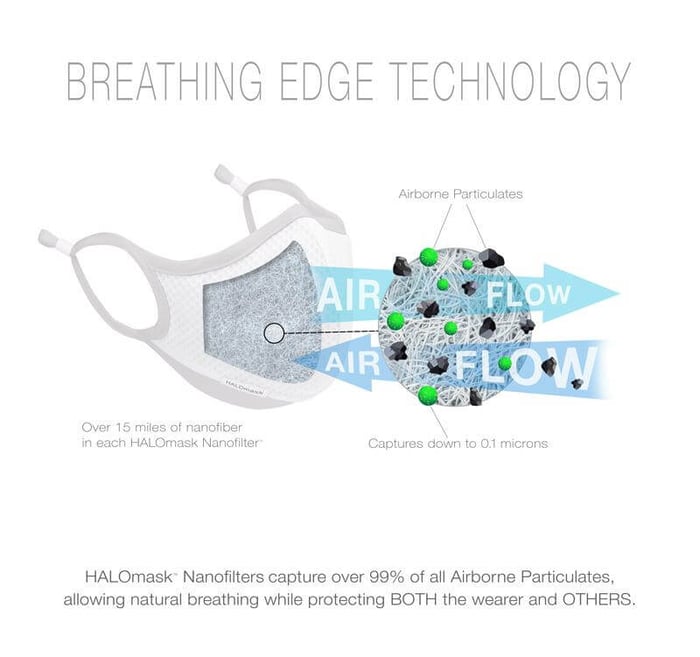Your Cart is Empty
As wildfires become more frequent and intense across the globe, the threat of smoke inhalation is no longer limited to people living directly in fire zones. In fact, smoke particles from distant wildfires can travel hundreds—or even thousands—of miles, affecting the air quality in cities far away from the flames.
For families, especially those with young children or individuals with respiratory conditions, protecting against wildfire smoke has become a real concern. One of the most effective defenses available today is the use of filtered fire masks—and not just any mask, but those designed specifically for both filtration efficiency and long-term comfort.

In this article, we explain how filtered fire masks work, who needs them, and how HALOmask’s advanced Nanofilter™ technology offers vital protection for adults and kids alike.
Wildfire smoke is a complex mixture of gases and microscopic particles. The most harmful component is particulate matter (PM2.5)—tiny airborne particles that are 2.5 microns or smaller. These particles can penetrate deep into the lungs, causing irritation, inflammation, and in some cases, long-term respiratory or cardiovascular damage.
Symptoms from exposure may include:
Coughing or throat irritation
Shortness of breath
Chest discomfort
Worsening of asthma or allergies
Fatigue or dizziness
Children are especially vulnerable because their lungs are still developing, and they breathe more rapidly than adults, increasing their exposure.
Filtered fire masks are protective face coverings designed to filter out harmful particles from wildfire smoke. Unlike cloth or surgical masks, which offer limited protection against airborne toxins, filtered masks use specialized materials to trap PM2.5 and other dangerous pollutants.
High-quality filtered fire masks feature:
Multiple protective layers
A secure face seal to reduce air leakage
Replaceable filters or built-in filtration media
Comfort features like adjustable ear loops and flexible nose bands
HALOmask offers a unique solution for families looking to defend against poor air quality, especially during wildfire season. With a sleek design and proven filtration performance, HALOmask stands out as a go-to option for both daily wear and emergency use.
The secret behind HALOmask’s effectiveness lies in its replaceable Nanofilter™, which has been independently tested to block 98.8% of airborne particles down to 0.3 microns—the size range most harmful in wildfire smoke. This includes:
PM2.5
Dust
Pollen
Smoke particles
Pathogens and allergens
This level of protection rivals some of the best non-medical filtration options available.
HALOmask comes in four different sizes, including options for children. With its adjustable ear loops and nose band, the mask ensures a snug fit, which is critical for maximizing filtration. A poor fit allows smoke particles to bypass the filter and enter the airway—a common issue with generic masks.
Wearing a mask for extended periods—especially in hot, smoky conditions—can be uncomfortable. HALOmask is crafted from lightweight, breathable materials that make long wear more tolerable for kids and adults alike.
While standard cloth masks may help reduce the spread of respiratory droplets, they do little to protect against smoke. In fact, the CDC has stated that cloth masks offer minimal protection from PM2.5 and wildfire smoke particles.
Key reasons include:
Lack of filtration layers
Loose fit around the nose and chin
No replaceable filter system
If you're relying on cloth or surgical-style masks during fire season, you may be giving yourself a false sense of security.
To maximize the benefits of filtered fire masks, follow these tips:
Choose the right size – Ensure a tight but comfortable fit, especially for kids.
Replace filters regularly – HALO Nanofilters should be replaced every 1–2 weeks with regular use, or after exposure to heavy smoke.
Keep extras on hand – Always have spare masks and filters available in your emergency kit.
Store masks properly – Keep them in a clean, dry place between uses.
Avoid strenuous activity outdoors – Even with a mask, limit outdoor exposure during poor air quality alerts.
Wildfire smoke isn’t going away any time soon, and families must take proactive steps to protect their lungs and long-term health. Filtered fire masks like those from HALOmask offer a reliable, comfortable, and scientifically backed way to breathe safer during fire season—and beyond.
Whether you're commuting, caring for kids, or preparing for an emergency, having a high-quality filtered fire mask on hand is no longer optional—it’s essential.
🔗 Explore HALOmask’s full range of fire-safe masks for adults and children at www.halolife.io